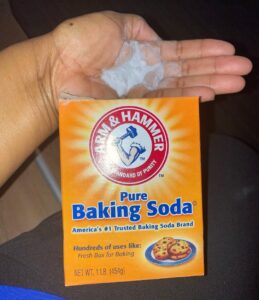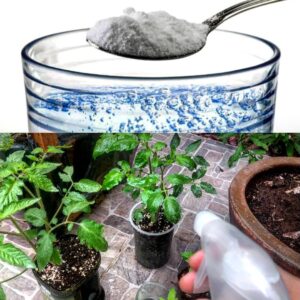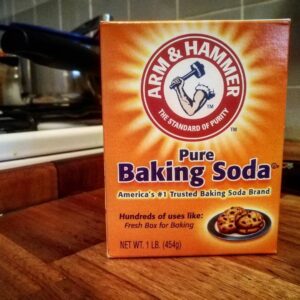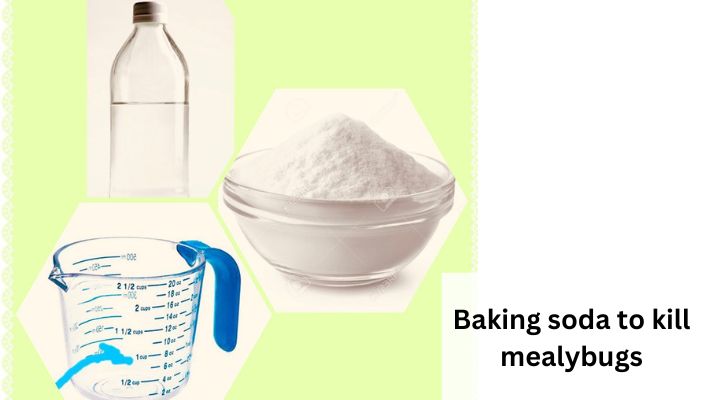Dealing with pests in our gardens or indoor plants can be a frustrating experience. One of the common culprits that gardeners and plant enthusiasts encounter is the pesky mealybug.
These tiny, white, cotton-like insects can wreak havoc on our beloved plants, causing stunted growth, yellowing leaves, and even plant death if left unchecked.
While chemical insecticides are readily available, many gardeners are seeking natural and safer alternatives to protect their plants.
Below, we’ll delve into the fascinating world of mealybugs and explore the potential of a household ingredient “baking soda” as a natural remedy to combat these pesky pests.
Mealybugs are notorious plant pests known for their knack for infesting a wide range of plants, including ornamentals, houseplants, and even fruit trees.
Their soft bodies are covered in a white, powdery substance, resembling tiny cotton balls or fluffy snowflakes. Despite their innocent appearance, mealybugs can multiply rapidly and cause significant damage if left unchecked.
Known for its versatility, baking soda has been used for countless purposes, from baking and cleaning to personal care.
And now, its potential as an insecticide against mealybugs has caught the interest of gardeners and plant enthusiasts.
In the following sections, we will dive into the world of mealybugs, understand their lifecycle, and explore how baking soda can be used to combat these unwelcome guests.
Understanding Mealybugs
Before we dive into the specifics of using baking soda as a mealybug killer, let’s take a moment to understand our tiny adversaries. Mealybugs are soft-bodied insects that belong to the family Pseudococcidae.
They are characterized by their small size, typically ranging from 1 to 4 millimeters, and their white, waxy, cotton-like appearance.
These sneaky critters are sap-sucking pests that feed on the plant’s juices by piercing through the tissue with their needle-like mouthparts.
Mealybugs are known to infest a wide range of plants, both indoors and outdoors. They are particularly fond of succulents, orchids, citrus trees, and houseplants.
The presence of mealybugs can cause significant damage to our plants. They weaken the plant’s immune system, leading to stunted growth, yellowing leaves, and leaf drop.
In severe cases, mealybug infestations can even cause plant death. That’s why it’s crucial to take action when we notice their unwelcome presence.

The Effectiveness of Baking Soda
One of the key benefits of using baking soda is its ability to disrupt the protective outer layer of mealybugs. The powdery texture of baking soda acts as a desiccant, meaning it absorbs moisture from the insects’ bodies, leading to dehydration and eventual death.
This drying effect can be particularly effective against soft-bodied pests like mealybugs. Moreover, baking soda alters the pH levels on the surface of the mealybugs.
These pests have a preference for an alkaline environment, but when exposed to baking soda, the pH shifts towards the acidic side, causing physiological stress and further weakening the insects.
Another advantage of using baking soda is its ability to deter mealybugs from settling on plants. The alkaline properties of baking soda make the plant’s surface less hospitable for these pests, making it less likely for them to establish colonies and cause damage.
The Science Behind Baking Soda’s Effectiveness:
To understand the science behind baking soda’s insecticidal properties, we need to explore the reaction that occurs when baking soda comes into contact with mealybugs.
When baking soda (sodium bicarbonate) encounters the moisture on the mealybugs’ bodies, it undergoes a reaction, releasing carbon dioxide gas. This gas acts as a desiccant, dehydrating the mealybugs and eventually causing their demise.
Additionally, the pH shift caused by baking soda disrupts the mealybugs’ internal systems. Mealybugs thrive in an alkaline environment, but the introduction of baking soda shifts the pH balance, creating an unfavorable condition for these pests. As a result, they struggle to maintain proper bodily functions and face increased vulnerability.
It’s important to note that while baking soda shows promise as an effective natural remedy for mealybugs, its success may vary depending on various factors such as the severity of the infestation, the specific plant species involved, and the environmental conditions.
How Baking Soda Kills Mealybugs
Baking soda, also known as sodium bicarbonate, exhibits several mechanisms that contribute to its effectiveness in killing mealybugs. Let’s take a closer look at how baking soda disrupts these pesky pests and ultimately leads to their demise.
- Desiccation: Baking soda acts as a desiccant when it comes into contact with mealybugs. The powdery texture of baking soda absorbs the moisture from the insects’ bodies, causing dehydration. Mealybugs rely on a moist environment to survive and reproduce. By drying out their bodies, baking soda strips away the essential moisture, ultimately leading to their death.
- pH Shift: Baking soda has an alkaline nature, and mealybugs thrive in an alkaline environment. However, when baking soda is applied, it causes a shift in the pH balance on the surface of the mealybugs. This shift towards the acidic side creates unfavorable conditions for pests. Mealybugs struggle to adapt to the altered pH, which disrupts their internal systems and weakens their overall health.
- Disruption of Protective Coating: Mealybugs have a protective waxy coating on their bodies that helps shield them from external threats. Baking soda disrupts this protective barrier by altering its composition. The alkaline nature of baking soda interferes with the structure of the waxy coating, making it less effective in protecting the mealybugs from external factors. As a result, the pests become more vulnerable to dehydration and other detrimental effects.
By combining its desiccating properties, pH-shifting abilities, and disruption of the protective coating, baking soda creates a hostile environment for mealybugs. It weakens their defenses, dehydrates their bodies, and ultimately leads to their demise.
It’s worth noting that the effectiveness of baking soda may vary depending on factors such as the concentration of the solution, the frequency of application, and the specific mealybug species and plant involved.
Monitoring the results and making adjustments as necessary is important for maximizing the success of using baking soda as a natural mealybug control method.
How to Use Baking Soda to Kill Mealybugs
Using baking soda to combat mealybugs is a simple and cost-effective solution. Follow these step-by-step instructions to prepare and apply a baking soda solution for effective pest control:

Step 1: Gather the necessary materials:
- Baking soda (sodium bicarbonate)
- Water
- Spray bottle
Step 2: Prepare the baking soda solution:
- In a clean container, mix 2 tablespoons of baking soda with 1 quart (1 liter) of water.
- Stir the solution thoroughly until the baking soda is dissolved.
Step 3: Fill the spray bottle:
- Transfer the baking soda solution into a spray bottle. Using a spray bottle allows for easy and targeted application.
Step 4: Prepare the affected plant:
- Inspect the plant for mealybug infestations. Pay close attention to the stems, undersides of leaves, and leaf axils where mealybugs tend to hide.
- If possible, gently remove any heavily infested plant parts, such as severely affected leaves or branches. Dispose of them properly to prevent further spread.
Step 5: Apply the baking soda solution:
- Shake the spray bottle well to ensure the solution is evenly mixed.
- Begin spraying the affected plant, making sure to thoroughly cover the infested areas.
- Direct the spray towards the mealybugs, ensuring the solution comes into contact with their bodies.
- Continue spraying until the affected plant is fully coated with the baking soda solution.
- Take care not to oversaturate the plant, as excessive moisture may cause other issues.
Step 6: Repeat the application:
- For optimal results, repeat the baking soda application every 5-7 days or as needed, depending on the severity of the infestation.
- Mealybugs often have a protective waxy coating that can make them resistant to treatments. Regular applications ensure that newly hatched nymphs and any missed mealybugs are also targeted.
Tips and Precautions for Safe and Effective Use:
- Conduct a patch test: Before applying the baking soda solution to the entire plant, it’s advisable to test a small area first to ensure the plant doesn’t exhibit any negative reactions, such as leaf discoloration or burning.
- Apply in suitable conditions: Choose a calm day with mild temperatures for spraying. Avoid applying the solution in extreme heat or direct sunlight, as it may cause stress to the plant.
- Target the mealybugs directly: Direct the spray towards the mealybugs and the areas where they congregate, such as leaf axils and undersides of leaves.
- Monitor the progress: Regularly inspect the plant to assess the effectiveness of the treatment. If mealybugs persist or the infestation worsens, consider alternative methods or seek professional advice.
- Maintain plant health: Alongside the baking soda treatment, provide your plants with proper care, including adequate sunlight, watering, and nutrition. Healthy plants are better equipped to resist pests.
By following these steps and taking necessary precautions, you can effectively utilize baking soda to combat mealybug infestations safely and naturally.
How frequently should to apply baking soda to kill mealybugs?
The frequency of applying baking soda to kill mealybugs may vary depending on the severity of the infestation and the specific plant species involved. As a general guideline, it is recommended to repeat the baking soda application every 5-7 days or as needed.
Regular treatments ensure that newly hatched nymphs and any missed mealybugs are targeted, enhancing the effectiveness of the control method.
Mealybugs can reproduce rapidly, so consistent application is crucial to break their life cycle and prevent re-infestation. By maintaining a regular schedule, you can disrupt the population growth and gradually eliminate the mealybugs from your plants.
During each application, ensure that the affected areas are thoroughly coated with the baking soda solution. Direct the spray towards the mealybugs, ensuring that it comes into contact with their bodies. However, avoid oversaturating the plant, as excessive moisture can lead to other issues such as fungal diseases.
While following the recommended frequency, it’s important to closely monitor the progress of the treatment. If mealybugs persist or the infestation worsens despite regular applications, consider alternative methods or seek professional advice. Some mealybug species may be more resistant to baking soda, and additional measures may be necessary to effectively control them.
Remember, maintaining overall plant health is also essential for preventing mealybug infestations. Providing your plants with proper care, including adequate sunlight, watering, and nutrition, helps them stay resilient and less attractive to pests.
By adhering to a consistent application schedule and monitoring the results, you can maximize the effectiveness of baking soda as a natural remedy for mealybugs and ensure the long-term health of your plants.

Other Natural Remedies for Mealybug Control
While baking soda can be an effective natural remedy for combating mealybugs, there are additional methods you can incorporate into your pest control strategy. Here are some other natural remedies to consider:
- Neem Oil: Neem oil is derived from the seeds of the neem tree (Azadirachta indica) and is known for its insecticidal and repellent properties. It disrupts the life cycle of mealybugs, inhibiting their feeding and reproduction. Dilute neem oil according to the instructions on the product and apply it to the affected plant, paying attention to the mealybug-infested areas.
- Insecticidal Soap: Insecticidal soaps are made from potassium salts of fatty acids and work by suffocating mealybugs and other soft-bodied pests. They penetrate the insects’ outer layer, causing damage to their cell membranes. Dilute insecticidal soap according to the instructions and apply it to the affected plant, ensuring thorough coverage of the mealybug-infested areas.
- Alcohol Spray: Isopropyl alcohol or rubbing alcohol can be an effective contact spray for mealybugs. Mix equal parts of alcohol and water in a spray bottle and apply it directly to the pests. The alcohol dissolves the protective waxy coating on the mealybugs’ bodies, leading to their dehydration and eventual demise. Take care not to use alcohol on sensitive or delicate plants, as it may cause damage.
- Beneficial Insects: Introducing beneficial insects that feed on mealybugs can be an environmentally friendly approach to control their population. Ladybugs and lacewings are natural predators of mealybugs and can help keep their numbers in check. You can attract these beneficial insects by planting nectar-rich flowers or using commercial releases of these insects.
- Physical Removal: For light infestations, manually removing mealybugs can be effective. Use a cotton swab dipped in rubbing alcohol or soapy water to gently wipe off the pests from the plant. Pay close attention to the hidden areas where mealybugs tend to congregate, such as leaf axils and stem joints.
- Horticultural Oil: Horticultural oils, such as mineral oil or petroleum-based oils, can be used to suffocate and smother mealybugs. Dilute the oil according to the instructions and apply it to the affected areas of the plant. The oil coats the pests, disrupting their respiratory system and leading to their elimination.
- Essential Oils: Certain essential oils have insecticidal properties that can help repel and control mealybugs. Peppermint oil, rosemary oil, and clove oil are known to have repellent effects on these pests. Dilute a few drops of the essential oil in water, and spray it on the affected plant, focusing on the areas with mealybug infestations.
- Garlic Spray: Garlic contains compounds that act as natural insecticides. You can make a garlic spray by blending a few cloves of garlic with water, straining the mixture, and then diluting it further. Spray the solution on the mealybug-infested areas to deter and control these pests.
- Diatomaceous Earth: Diatomaceous earth is a powdery substance made from the fossilized remains of marine organisms. It works by physically damaging the exoskeletons of mealybugs and dehydrating them. Sprinkle a thin layer of diatomaceous earth around the base of the affected plant or directly on the pests.
- Sticky Traps: Sticky traps can be useful in monitoring and capturing adult mealybugs. Place yellow sticky traps near the infested plant to attract and trap the pests. This method helps reduce their population and gives you an idea of the severity of the infestation.
- Pruning and Quarantine: If a plant is heavily infested and difficult to control, consider pruning off severely affected parts or even removing the entire plant. Quarantine newly acquired plants to ensure they are free from mealybugs before introducing them to your other plants.
Remember to assess the suitability of each method for your specific plant species and take precautions when using any remedy. It’s essential to maintain a balance between pest control and preserving the overall health of your plants and the surrounding environment.
By exploring these additional options and combining them with the previously mentioned remedies, you can create a comprehensive approach to managing mealybug infestations naturally.
Remember to combine these natural remedies with good cultural practices to create an environment that is less favorable for mealybug infestations. Regularly inspect your plants, maintain proper hygiene, and avoid overcrowding or overwatering, as these conditions can attract pests.
If the infestation persists or becomes overwhelming, it may be necessary to seek professional assistance or consider using chemical insecticides as a last resort. However, always prioritize environmentally friendly and least toxic options for the health of your plants and the ecosystem.
Will Baking Soda Kill Mealybugs FAQs
Can baking soda harm plants?
Baking soda, when used appropriately, is generally considered safe for plants. However, it’s important to follow the recommended dilution and application guidelines.
Using a baking soda solution that is too concentrated or applying it excessively can potentially harm plants, especially sensitive ones. It’s always a good idea to conduct a patch test on a small area of the plant before applying it to the entire plant.
Additionally, some plants may be more sensitive to baking soda than others, so it’s advisable to research specific plant species and their tolerance to baking soda before use.
Is baking soda safe to use around children and pets?
Baking soda is generally considered safe for use around children and pets. It is a commonly used ingredient in many household products and is non-toxic when ingested in small amounts.
However, it’s important to take precautions to prevent direct ingestion of baking soda by children or pets. Store baking soda and any prepared solutions out of their reach.
When applying baking soda to plants, keep children and pets away from the treated areas until the solution has dried. While baking soda is generally safe, it’s always a good practice to exercise caution and ensure proper safety measures are in place.
How long does it take for baking soda to kill mealybugs?
The time it takes for baking soda to kill mealybugs can vary depending on factors such as the concentration of the solution, the severity of the infestation, and the specific mealybug species.
In general, the effects of baking soda on mealybugs are not immediate. It takes time for the baking soda to disrupt the protective coating on the pests’ bodies and cause dehydration. You may begin to see results within a few days to a week after application.
However, it’s important to note that the complete elimination of mealybugs may require multiple applications over several weeks to effectively control their population. Consistency and regular monitoring are key to achieving desired results.
Are there any risks associated with using baking soda for pest control?
When used properly, baking soda is considered a safe and environmentally friendly option for pest control. However, there are a few risks to be aware of:
- Plant Sensitivity: Some plants may be more sensitive to baking soda than others. It’s important to conduct a patch test on a small area of the plant before applying baking soda to the entire plant. If the plant shows signs of leaf discoloration, burning, or other negative reactions, it may be more sensitive, and the baking soda treatment should be discontinued.
- pH Imbalance: Baking soda is alkaline, and its use over time can affect the pH balance of the soil. This can potentially cause nutrient deficiencies or imbalances in plants. It’s recommended to use baking soda treatments sparingly and monitor the pH levels of the soil to prevent any long-term negative effects.
- Beneficial Insects: Baking soda does not discriminate between harmful pests and beneficial insects. If the baking soda solution comes into direct contact with beneficial insects, it may harm or disrupt their activities. It’s important to apply the solution specifically to the affected areas and avoid spraying it indiscriminately.
To mitigate these risks, it’s advisable to follow the recommended guidelines for baking soda application, conduct patch tests, and monitor the plant’s response.
Additionally, incorporating other natural pest control methods and practicing good cultural practices can help maintain a balance between pest management and the overall health of your plants.
What other pests can baking soda control?
Baking soda is primarily known for its effectiveness in controlling fungal diseases and certain soft-bodied pests like mealybugs. However, it may have limited efficacy against other pests. Some pests that baking soda may help control to some extent include:
- Aphids: Baking soda can help deter aphids by disrupting their feeding and detaching them from plant surfaces. However, it may not be as effective against heavy aphid infestations or certain aphid species.
- Spider Mites: Baking soda may help control spider mites by interfering with their ability to feed and reproduce. However, spider mites are known for their ability to develop resistance to various treatments, including baking soda. Therefore, it may not provide complete control in severe cases.
- Whiteflies: Baking soda can have some repellent effects on whiteflies. It may deter them from settling on plants or make it harder for them to feed. However, comprehensive control of whiteflies usually requires a combination of methods, including insecticidal soaps or oils.
While baking soda may offer some level of control against these pests, it’s important to note that its effectiveness can vary depending on the specific pest species and the severity of the infestation. If the pest problem persists or worsens, it’s advisable to consider other targeted pest control methods or consult with a professional.
Conclusion
Baking soda can be a highly effective and safe natural remedy for combating mealybug infestations. Throughout this article, we have explored the benefits and science behind using baking soda, as well as the mechanisms by which it kills mealybugs.
We have also provided step-by-step instructions on preparing and applying a baking soda solution, along with tips for safe and effective use.
Baking soda works by disrupting the protective coating on mealybugs’ bodies, leading to their dehydration and elimination. It offers a non-toxic alternative to chemical insecticides, making it a favorable choice for those seeking environmentally friendly pest control methods.
Baking soda, when used appropriately, is generally safe for plants, children, and pets. While the time it takes for baking soda to eliminate mealybugs may vary, consistent and regular application can yield positive results within a few days to a week.
Furthermore, we have highlighted other natural remedies for mealybug control, providing a comprehensive range of options for readers to consider.
These include neem oil, insecticidal soap, alcohol sprays, beneficial insects, and physical removal, among others. By combining these methods and adopting good cultural practices, readers can create an effective pest control strategy.
